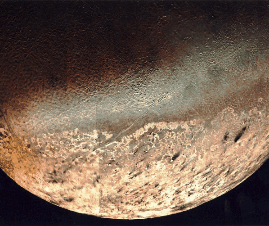 Neptune has two large moons that are easily seen from Earth, Triton and Nereid.
Voyager 2
discovered six additional moons. One of these is actually larger than Nereid,
but could not be seen easily from Earth because it orbits close to Neptune.
Neptune has two large moons that are easily seen from Earth, Triton and Nereid.
Voyager 2
discovered six additional moons. One of these is actually larger than Nereid,
but could not be seen easily from Earth because it orbits close to Neptune.
 Neptune has two large moons that are easily seen from Earth, Triton and Nereid.
Voyager 2
discovered six additional moons. One of these is actually larger than Nereid,
but could not be seen easily from Earth because it orbits close to Neptune.
Neptune has two large moons that are easily seen from Earth, Triton and Nereid.
Voyager 2
discovered six additional moons. One of these is actually larger than Nereid,
but could not be seen easily from Earth because it orbits close to Neptune.
Voyager 2 found some of the most varied terrain in the Solar System, a thin atmosphere, and even evidence for ice volcanoes on Triton. The dark streaks seen in this image are material spread downwind from recent volcanic eruptions. Giant faults cross the surface of Triton. The favored mechanism for the volcanoes is that the Sun heats darkened methane ice on the surface, which heats underlying nitrogen ice that vents through the surface volcanoes (more info).